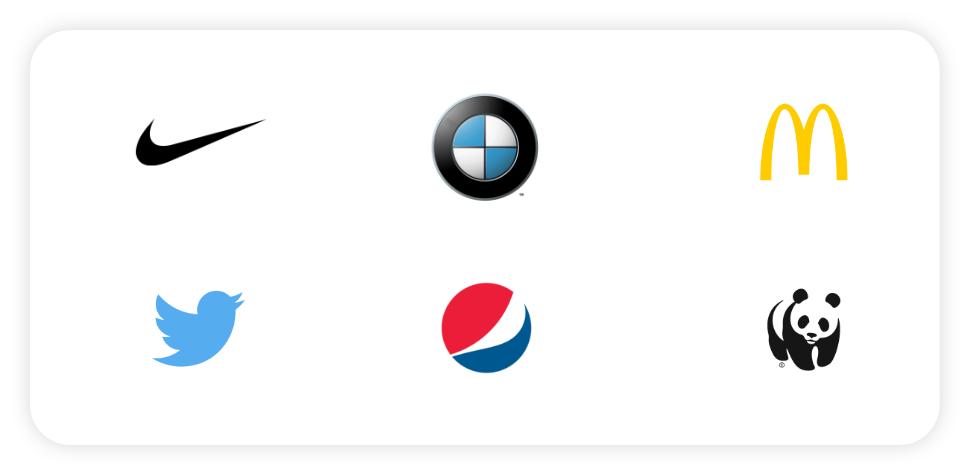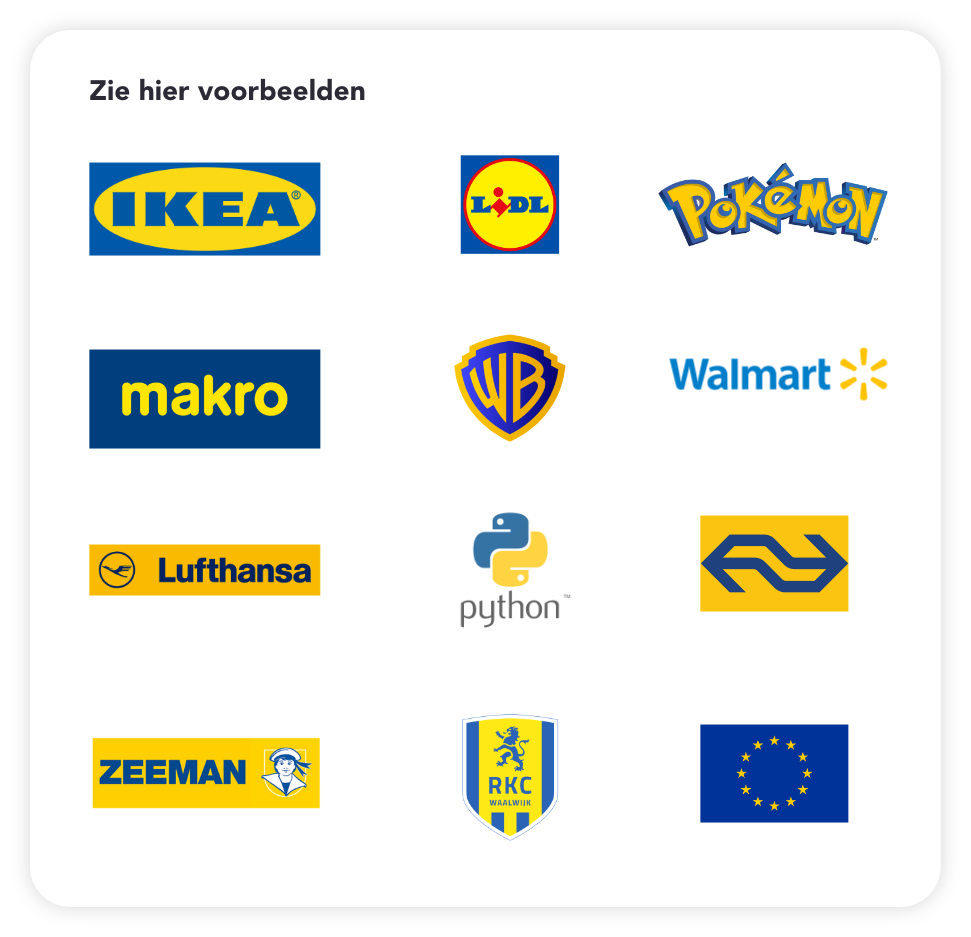Checklist: 10 elements that make your company recognized
How do you get more customers? That's the challenge of every business. You want more sales, more growth, to be relevant. The start of this lies in the following: as a company you have to be recognizable. So not just visible, but truly recognizable. But why is that so important and how do you ensure that potential customers recognize your company?

Let's take a little test. How many of these logos do you immediately recognize?

Do you know why you know these brands? Because they are always and everywhere used in advertisements, as well as in communications and on products. Just think about BMW's cars. On every car, as well as on other BMW products, you see the brand. The big M of McDonald's is the big trigger for children when they are in the car on the highway (super irritating as a parent, by the way) and is consistently incorporated into all packaging, products, games and locations. Several times a day you see these symbols pass by, consciously and subconsciously and you as a customer store that.
We also did a test among our followers. We asked them to name a logo with blue and yellow in it. How many do you know how to name?

Why recognition is crucial to sales
Nice to hear all those big companies, but I as an SME don't have that time and budgets,' I can hear you thinking. Not everyone can or wants to become a Coca-Cola. Yet several SMEs have already proven that with small actions, you can become known and recognized by your specific target group.
There are several examples: think of Vegatarische Slager among people who want to eat less or no more meat. Or how about Belsimpel? Founders Jeroen and Jeroen have outgrown the SME, but came up with the concept for the company at the kitchen table of their student house in Groningen. Because their online marketing is rock solid, you'll always run into them if you want to buy a new laptop or mobile phone online.
Be consistent
Start with consistency. So that your target audience recognizes your brand: in any form, in every action they encounte
Consistentie is niet duur. Je doet wat je nu doet, maar dan anders: met focus en met aandacht voor consistentie. Niet meer vanalles wat doen.
Focus only on the relevant people
You don't need to become known to the whole world, only to your specific target audience. And that might only be a few hundred people in your area. Or a few thousand people with the same problem for which you have a solution. This choice also helps you focus and keep your marketing small and targeted. Once your target audience recognizes your brand, it also creates a sense of knowing. They begin to become familiar with what to expect from the brand because of the clear communication that is constantly there. As a result, they gain more and more trust in the brand; they even develop a personal connection with it. All this leads to the following: potential customers begin to see your company as an expert in your industry. You need that expert status to be preferred over other companies in your industry. People are more strongly attracted to your brand because they know it better. And that's good for sales. Our advertising world has sworn by it for years. The more often you expose people to your brand, the better they know the brand, the more they like your brand. Seeing a brand often makes people think more positively about it. A one-time exposure often accomplishes nothing. How do you get people to recognize your business? Completing this checklist will get you off to a flying start. Make sure your positioning is clear. In short, positioning is the position you want your company to occupy in the mind of your target audience. You do this by making your brand unique, a one-of-a-kind. Can you tell what sets your company apart from the other brands in your industry? And is that something other brands also say or is this differentiation truly unique? Good positioning is a craft. Every self-respecting company has a logo. The key to a recognizable logo is: keep it simple. Just look at logos that rank in the top of recognizability. We recognize these logos because you see them everywhere. Just look at the shoes passing by, the apple on your Macbook that will shine so beautifully when you turn on the laptop. Most successful companies work with a signature color. A signature color can increase your recognition by 80%. (see study here). Think of the blue of KLM, the pink of T-Mobile, the blue of Tiffany's and the green of Starbucks. The color is seen everywhere in their advertising and communications and is engrained in our brain. You may even recognize the companies if you only see the color. How do you want to come across with your business? Shapes accentuate the appearance of your business. Angular shapes are more aggressive than soft shapes. A circle represents community, connection, positivity, unity and culture. If you go for a triangle, then you exude more edginess, strategy and power. Transportation company FedEx, for example, has a triangle in its logo, incorporated into an arrow. The rectangle is more common in banks and law firms. It stands for trust, security and stability. If you choose a particular font, or even better, have a font developed, you can implement it in all of your company's communications. From the email to a potential customer to the titles in your socials. If everything is invariably the same, it means a significant improvement in your recognizability. The tone with which you communicate also contributes to your visibility. Do you want to come across as serious, reliable or funny? Passionate, expert or perhaps more neutral? Pictures have an important function: they make you feel and, as a result, they stick with those who see them longer. This is because your brain processes images differently from text. Images are processed in the right hemisphere of the brain; that is where emotions have a place. Therefore, images evoke emotions more easily than texts. We've mostly talked about visual visibility so far, but don't forget audiovisual visibility. Sound is super strong in evoking emotions, recognition and memories. Slogans, taglines and Pay-Offs are also (partly) audiovisual. They are three phrases that all have different purposes. The slogan is part of a campaign, the tagline clarifies a company's activities and the pay-off is the promise a company makes. Of course, there is a lot involved in setting up something like this properly, but the most important thing is: keep it short and sweet and focus on the essence of your brand. How you then articulate that is essential to the success of the "cry. Jonah Berger has written a fantastic book about that: Contagious: Why Things Catch On (view the book here). In this book, he gives 6 steps (STEPPS) or ingredients to create content that resonates with people. There are several companies that attach a (famous) face to their brand. This is a way to give more personality to your brand. Max Verstappen was hired by several brands: Jumbo, Ziggo and G-Star. Suppose you are also in a similar situation (1 person, multiple brands), consider carefully what the association with those brands does to your brand. “I strive for two things in design: simplicity and clarity. Great design is born of those two things.”
- Lindo Leader, Graphic Designer and Creator of the FedEx
Herkennen wordt waarderen
Be the expert
Did you know that customers are more likely (up to more than ten times) to buy from a brand they know and trust? They are also willing to pay higher prices. Of course, there are always people who don't need your product or service, but because they know the brand, they are more likely to recommend your company to people who could be your customers. In short, recognition leads to more sales and growth of your business. That's because of something we call the Mere Exposure Effect.Mere Exposure Effect
10 checks for ultimate recognition
1. Positioning
2. Logo

Sometimes the logo consists of just a name, but we also regularly add an image mark. There are several functions for the logotype. It clarifies what the company does, think of the Play button at YouTube. But also just as often, it is an image that contributes to the look and feel of the brand. For example, the elephant in Côte d'Or's logo has nothing to do with the chocolate, but represents the strength of the brand, its appearance.3. Colors

4. Shapes
5. Fonts
6. Tone of Voice
The tone of voice is in what you say (the content) and how you say it (the packaging). You tailor those to: 7. Photos
Do you use smiling people, nature or modern buildings in your photos? Whatever you choose, it adds to the look of your business. Make sure your photos are in the same style and that the quality is good. Possible style elements:8. Jingle/Tune
What is a jingle?
A jingle is a short piece of music, containing singing or speech, to promote brand recognition. They were often used in advertisements on the radio, but now you see them a lot in online advertisements as well.
What is a tune?
Jingles and tunes are often used interchangeably in practice. A tune is a music track that is often used at the beginning of a program or video. Nowadays you also see more and more tunes in online videos of companies, which again gives extra recognition.
Een paar voorbeelden:You can probably hum along to several tunes and jingles. Think of the tune from Douwe Egberts, jingle from Q-Music or the sound at the end of the Rolo commercial with the elephant.
The most important thing in building recognition with audio is to use it consistently in every expression. Not only in advertising, but also on the website, in the app and if possible in the store. You can use different variations, as long as it remains essentially the same. If you start using totally different tunes, it becomes unclear and confusing and the recognizability decreases. For example, you can use the same tune, but played by a live orchestra, or make a techno version of it. Zolang dat deuntje, wat iedereen herkent er maar consequent in zit. “Music gives a soul to the universe, wings to the mind, flight to the imagination, and life to everything.”
- Plato
9. Slogan, Tagline en Pay-off
Just another test: what brand do you think of when I shout:
‘I’m Lovin It!’
‘Just do it’10. (Familiar) faces
Less famous people also do well in recognition; if we see them often enough, we automatically get to know them. Just think of Cora from Mora (Juliëtte de Wijn), who we have seen in Mora's commercials for 30 years. And what face do you see before you when you think of Albert Heijn? Probably that of Harry Piekema. The name may not tell you much, but when you see his face, you immediately know and you may spontaneously start singing: 'Hamburgers with discount, ohohohohoh' or exclaim: 'Hamsterennnn'.
The more there are, the more likely your company, your brand will become recognizable to your target audience. Which items on the checklist were you able to check off?
Now if you want to learn more about this and really get started, sign up for the online training. Click here to enroll.
Ontdek de 7 geheimen van goede reclame
In deze online training geven professionele reclamemakers hun 7 belangrijkste tips. Zodat jouw marketing euro’s wél klanten opleveren.





